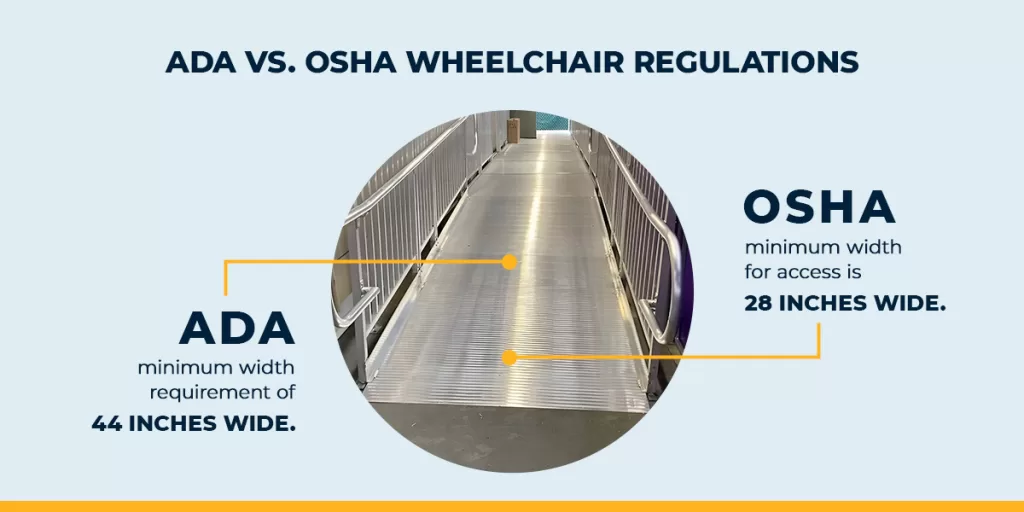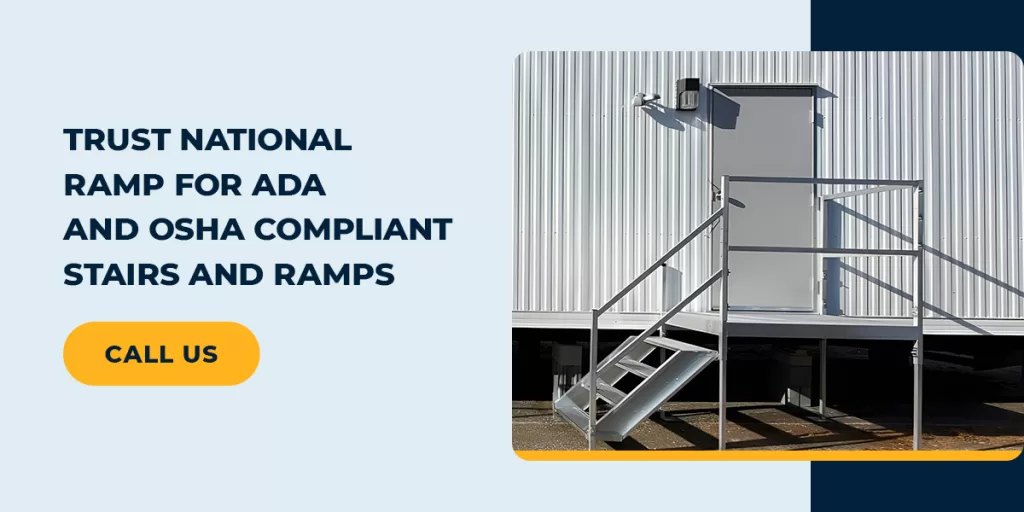
ADA and OSHA compliance is essential for private and public buildings. These standards stipulate width, depth, tread and other requirements that you need to follow for compliance. There are specific requirements for stairways, walkways, ramps and platforms that help to create safe working environments and allow for accessibility for people with disabilities. In this article, we’ll look at the requirements and standards for fixed stairways, ramps and walkways.
What Is OSHA?
The Occupational Safety and Health Administration (OSHA) ensures safe and healthy working conditions for workers across all 50 states. Since OSHA’s inception, workplace fatalities have gone down by 60% and there has been a 40% decrease in the number of workplace-related injuries and illnesses.
The regulations that it sets and enforces extend to the walking surface in places of employment. In the OSHA’s Walking-Working Surfaces Standard 29 CFR Part 1910, you’ll find the laws that govern walking surfaces, including stairs, walkways and ramps. This standard helps employers protect their workers from trips, slips and falls at work.
What Is ADA?
The Americans with Disabilities Act (ADA) protects people with disabilities from discrimination in all public and private areas, including schools, malls, places of employment and transportation. ADA laws and regulations ensure that people with disabilities have the same rights as everyone else. Part of this means ensuring that people with disabilities can physically access commercial, government and private buildings. The accessibility regulations are outlined in the Accessibility for Buildings and Facilities guidelines. The Access Board also provides organizations with training and guidance on these regulations.
Differences Between OSHA vs. ADA
OSHA and ADA have differing regulations for stairs and walkways. To remain compliant, you must adhere to these guidelines when constructing your stairs and walking surfaces. Let’s look at how these regulations differ.
OSHA Stair Requirements
OSHA Standard 29 CFR 1910 Subpart D governs walking surfaces and covers a multitude of stairways, including spiral, ship, alternating thread-type and ladders. Let’s take a look at the regulations for standard stairs, which are fixed or permanently installed stairs:
- The steps must have a minimum landing of 22 inches wide and 30 inches deep.
- If steps have four or more risers, they must have guardrails and handrails.
- The variation in riser height must be less than ¼ inch.
- You must install stairs at 30 degrees to 50 degrees from the horizontal.
- Vertical clearance above any stair tread to an overhead clearance must be at least 8 inches.
The surface of the stairs is also an important factor. To keep workers from slipping, you must also apply a static coefficient of friction (COF) of at least 0.5. This COF is not the absolute standard. Some places may require a higher COF for certain work surfaces where you need to carry objects up and down.
ADA Stair Requirements
Similar to OSHA, the ADA also has standards for the design of stairs in private and public buildings. Let’s look at the regulations for fixed stairways.
- All steps must be the same depth and height.
- Step height must be between 5 and 7 inches.
- The depth of the steps must be at least 11 inches. This is measured from riser to riser.
- The opening width of stairs must be at least 36 inches.
- Handrails must have a height of 34 to 38 inches starting from the tip of the stair nosing.
- The handrails must be smooth and continuous and have a minimum 1 ½ inch gap between an adjacent surface.
- At the top of the stairs, handrails must level out and carry on for 12 inches.
- All handrails must end in a wall, landing surface, guard or continue with another handrail.
- The top and bottom of each set of stairs must have a landing. Another landing is required for every 12 feet of vertical rise.
The surface of the stairs must be stable, firm and slip-resistant and have no greater slope than 1:48. Similar to the OSHA, ADA also stipulates the COF. They recommend a higher COF of 0.6 for accessible routes and 0.8 for ramps.
ADA vs. OSHA Wheelchair Regulations
Both the ADA and OSHA stipulate that buildings need to accommodate wheelchair accessibility. The OSHA requirement 1910.36 governs wheelchair access and states that the minimum width for access is 28 inches wide. The ADA often overrides this with a minimum requirement of 44 inches wide for wheelchair access. Title 1 of the ADA also states that employers only have to make the workplace wheelchair accessible once an employee or applicant with a disability requires such access.
Occupational safety and health standards require that entry and exits must have a ramp at a suitable level to allow for safe wheelchair accessibility. The ADA outlines the following requirements for ramps:
- A uniform running slope of 1:12 maximum and cross slope of maximum 1:48 maximum
- A clear width that is a maximum of 36 inches
- A maximum run height of 30 inches
- A level landing at the top of each run with changes at the landings less than 1:48
OSHA also requires private and public buildings to post wheelchair entry and exit points to be posted on a floor plan that is visible to disabled and non-disabled persons. The ADA also requires organizations to display ADA-approved signage — this signage must be low enough to be visible to those in wheelchairs.

ADA vs. OSHA Walkway Width Requirements
Occupational health standards don’t specify minimum pedestrian walkway or aisle widths unless it’s an emergency route, in which case the minimum requirement is 28 inches. That being said, the width of the route must match the maximum occupancy, so it may need to be wider than 28 inches.
However, the Americans with Disabilities Act does stipulate that a passing space must have a width of 36 inches. Every 200 feet, the width must widen to 60 inches to allow wheelchairs and pedestrians to pass each other.

Trust National Ramp For ADA and OSHA Compliant Stairs and Ramps
Public and private buildings must adhere to ADA and OSHA regulations to stay compliant, create safe working conditions and allow for accessibility for persons with disabilities. Each type of stairway, be it fixed, spiral or ladder, has its own set of requirements that you’ll need to incorporate in your stairway design. Knowing the specifications is important to get the design right.
At National Ramp, we are industry experts and well-versed in OSHA and ADA regulations. We can install ramps, stairs, walkways and platforms quickly and efficiently and will work with architects and contractors to provide quotes and drawings for your projects. You can trust us for durable and quality USA-made products. Contact us online to learn more about our OSHA and ADA-compliant stairs and ramps.
Don’t Risk Injury To You Or A Loved One
Why wait? Give us a call at 877-596-7293 or contact us online to get started!

